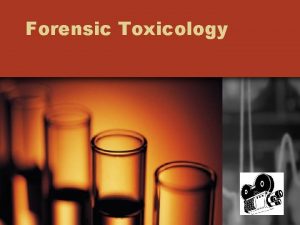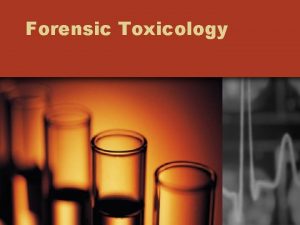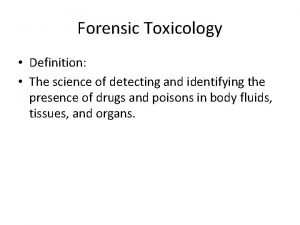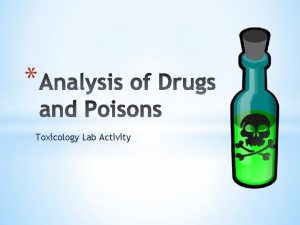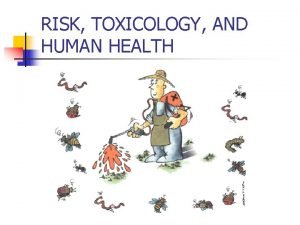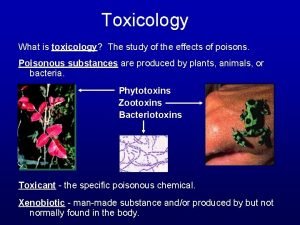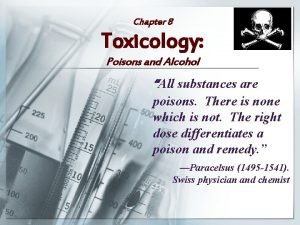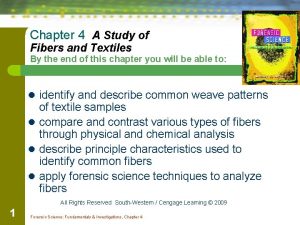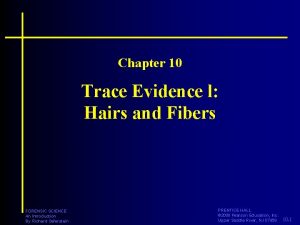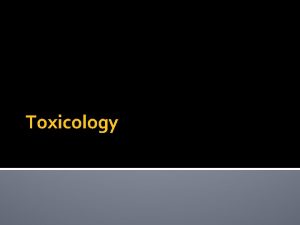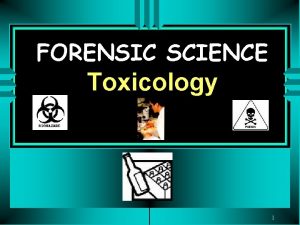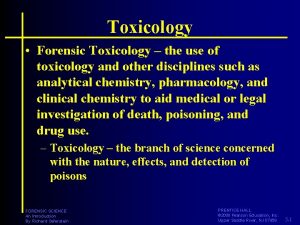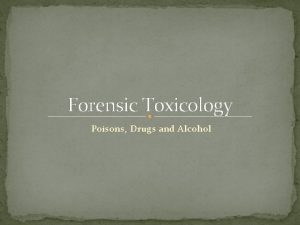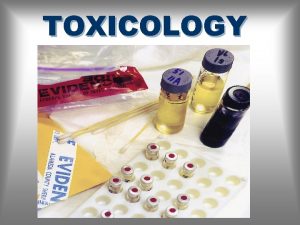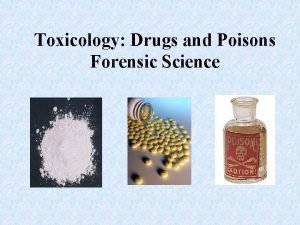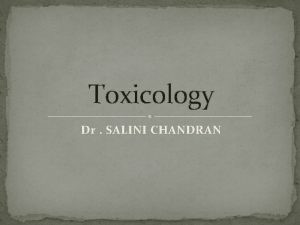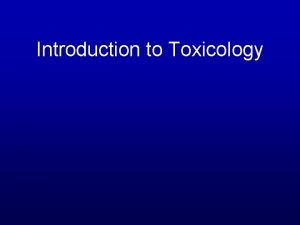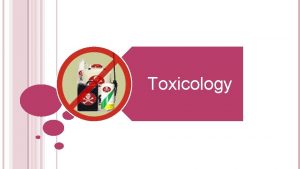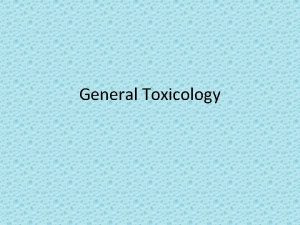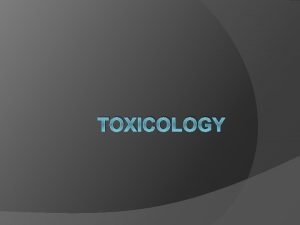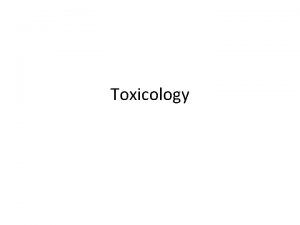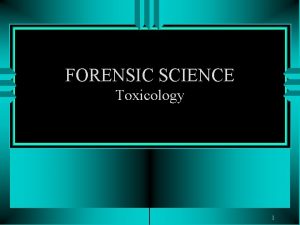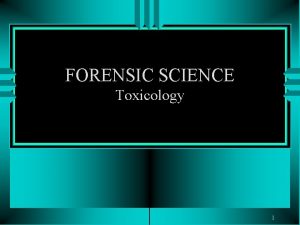Forensic Toxicology Forensic Science Copyright and Terms of























- Slides: 23

Forensic Toxicology Forensic Science

Copyright and Terms of Service Copyright © Texas Education Agency, 2011. These materials are copyrighted © and trademarked ™ as the property of the Texas Education Agency (TEA) and may not be reproduced without the express written permission of TEA, except under the following conditions: 1) Texas public school districts, charter schools, and Education Service Centers may reproduce and use copies of the Materials and Related Materials for the districts’ and schools’ educational use without obtaining permission from TEA. 2) Residents of the state of Texas may reproduce and use copies of the Materials and Related Materials for individual personal use only, without obtaining written permission of TEA. 3) Any portion reproduced must be reproduced in its entirety and remain unedited, unaltered and unchanged in any way. 4) No monetary charge can be made for the reproduced materials or any document containing them; however, a reasonable charge to cover only the cost of reproduction and distribution may be charged. Private entities or persons located in Texas that are not Texas public school districts, Texas Education Service Centers, or Texas charter schools or any entity, whether public or private, educational or non-educational, located outside the state of Texas MUST obtain written approval from TEA and will be required to enter into a license agreement that may involve the payment of a licensing fee or a royalty. Contact TEA Copyrights with any questions you may have. Copyright © Texas Education Agency 2011. All rights reserved. Images and other multimedia content used with permission. 2

Role of Forensic Toxicology • Toxicology is the study of drugs and poisons, and their interactions with or effects on the body • A drug is a natural or synthetic substance that is used to produce physiological or psychological effects • Forensic Toxicology is the application of toxicology to the law, including – Workplace or Forensic Drug Testing – Postmortem Toxicology – Human Performance Testing Copyright © Texas Education Agency 2011. All rights reserved. Images and other multimedia content used with permission. 3

Toxicology of Alcohol • Approximately 40% of traffic deaths in the U. S. are alcohol-related (Flinn, 2012) • Toxicologists have had to develop specific procedures for measuring the degree of alcohol intoxication • Methods for diagnosis must be defendable within the framework of the legal system Copyright © Texas Education Agency 2011. All rights reserved. Images and other multimedia content used with permission. 4

Toxicology of Alcohol (continued) • Metabolism involves the body’s ability to break down chemicals. There are three steps: – Absorption • Alcohol appears in the blood minutes after consumption • Alcohol slowly enters the body’s bloodstream and is carried to all parts of the body Copyright © Texas Education Agency 2011. All rights reserved. Images and other multimedia content used with permission. 5

Toxicology of Alcohol (continued) • Metabolism (continued) – Distribution • When absorption is complete, alcohol becomes distributed uniformly through the “watery” parts of the body • Factors affecting absorption and distribution are – – Speed of consumption Percentage of alcohol content Quantity of alcohol consumed Quantity and type of food present in the stomach Copyright © Texas Education Agency 2011. All rights reserved. Images and other multimedia content used with permission. 6

Toxicology of Alcohol (continued) • Metabolism (continued) – Elimination • The body begins to eliminate alcohol as it is circulated through the bloodstream • There are two mechanisms for elimination – Oxidation, which occurs in the liver – Excretion through breath, urine, and perspiration Copyright © Texas Education Agency 2011. All rights reserved. Images and other multimedia content used with permission. 7

Toxicology of Alcohol (continued) • To determine the blood alcohol level, analyzing brain tissue would be best. However, brain tissue is not available from a living individual, so blood alcohol concentrations are used. Blood and brain concentrations are directly proportional • Measuring the quantity of alcohol consumed can be done by analyzing either blood or breath Copyright © Texas Education Agency 2011. All rights reserved. Images and other multimedia content used with permission. 8

Toxicology of Alcohol (continued) • Testing for Intoxication – Breath testing • The most widespread method • The Breathalyzer measures alcohol content in alveolar breath (deep within the lungs) • It requires no less than 1. 1 to 1. 5 liters of breath to ensure that “deep -lung” breath is measured • For accuracy, avoid “mouth alcohol, ” such as that from belching, regurgitation, or recent mouthwash Copyright © Texas Education Agency 2011. All rights reserved. Images and other multimedia content used with permission. 9

Toxicology of Alcohol (continued) • Testing for Intoxication (continued) – Field Sobriety • A preliminary test performed to ascertain the degree of a suspect’s physical impairment and whether further tests are justified Copyright © Texas Education Agency 2011. All rights reserved. Images and other multimedia content used with permission. 10

Toxicology of Alcohol (continued) • Testing for Intoxication (continued) – Field Sobriety (continued) • Psychophysical tests – Horizontal-gaze nystagmus – Walk and turn – One-leg stand Copyright © Texas Education Agency 2011. All rights reserved. Images and other multimedia content used with permission. 11

Toxicology of Alcohol (continued) • Testing for Intoxication (continued) – Field Sobriety (continued) • Preliminary Breath Test – A handheld breath tester that uses a fuel cell to measure alcohol content – Should establish probable cause for requiring more thorough breath or blood tests Copyright © Texas Education Agency 2011. All rights reserved. Images and other multimedia content used with permission. 12

Toxicology of Alcohol (continued) • Blood Analysis – Calculated with a high degree of accuracy by use of gas chromatography which separates alcohol from any other chemicals – Collection and preservation of blood • Before the penetration of the needle, the area must be cleaned with non-alcoholic disinfectant • Refrigerate the blood until it is delivered to the lab • Effects on the collected blood – Storage temperature – Presence of a preservative, such as sodium fluoride – Amount of time in storage • Postmortem blood should be collected from a variety of body sites if it is available at all Copyright © Texas Education Agency 2011. All rights reserved. Images and other multimedia content used with permission. 13

Toxicology of Alcohol (continued) • Blood Alcohol Laws (Morgan, 2012) – The Department of Transportation recommended that states adopt. 08% blood alcohol concentration as the legal measure for drunk driving – This percentage has been adopted by all 50 states –. 08% only applies to noncommercial drivers; for commercial drivers, it is. 04% – An implied consent law is used to prevent a person from refusing to take a blood or breath test based on self-incrimination rights Copyright © Texas Education Agency 2011. All rights reserved. Images and other multimedia content used with permission. 14

Role of the Toxicologist • Studies body fluid, tissue, and organs for drugs and/or poisons • May conduct postmortem pathological examinations, and examination of personal effects and empty containers, etc. • May have extremely minute quantities to test • Must detect, identify, quantify, and assess toxicity Copyright © Texas Education Agency 2011. All rights reserved. Images and other multimedia content used with permission. 15

Collecting and Preserving Toxicological Evidence • When possible, collect both blood and urine – Collect two voids (samples) of urine in separate specimen containers – Collect a sample of blood if a physician or registered nurse (RN) is available (the amount depends upon the type of test to be conducted) Copyright © Texas Education Agency 2011. All rights reserved. Images and other multimedia content used with permission. 16

Techniques in Toxicology • Drugs are chemicals that are categorized as either acids or bases – An acid is a compound that donates hydrogen ions – A base is a compound that accepts hydrogen ions – The p. H scale measures the strength of acids and bases • The scale measures from 0 – 14 • 7 is neutral; the farther the number is away from 7, the stronger the acid or base • Below 7 are acids and above 7 are bases Copyright © Texas Education Agency 2011. All rights reserved. Images and other multimedia content used with permission. 17

Techniques in Toxicology (continued) • Screening Tests – Thin Layer Chromatography (TLC) • Separates out molecules that move up a thin coated plate • This test has both a solid and a liquid phase • The distance each component travels is based on the characteristics of that substance • It is then compared to known samples – Gas chromatography uses the same process as TLC except it has a moving liquid and a moving gas phase – Immunoassay is based upon specific drug-antibody reactions; this is the best method for detecting low drug levels Copyright © Texas Education Agency 2011. All rights reserved. Images and other multimedia content used with permission. 18

Techniques in Toxicology (continued) • Confirmation Test – Gas chromatography/Mass spectrometry • The gas chromatography is completed first • Then each separated component enters the mass spectrometer where the sample is broken into fragments for identification Copyright © Texas Education Agency 2011. All rights reserved. Images and other multimedia content used with permission. 19

Techniques in Toxicology (continued) • Detecting Drugs in Hair – Drugs remain in the • Bloodstream up to 24 hours • Urine up to 72 hours – Drugs can become permanently entrapped in a hair’s hardening protein – As hair grows, the drug’s location on the hair shaft becomes a marker for the time of drug intake – Some drugs may enter a hair’s surface from environmental exposure or sweat. This can cause a problem with the accuracy of the test Copyright © Texas Education Agency 2011. All rights reserved. Images and other multimedia content used with permission. 20

Techniques in Toxicology (continued) • Detecting Non-drug Poisons – Heavy metals such as arsenic and mercury may be detected – Carbon monoxide is one of the most commonly encountered poisons Copyright © Texas Education Agency 2011. All rights reserved. Images and other multimedia content used with permission. 21

Techniques in Toxicology (continued) • Significance of Toxicological Findings – once a drug is identified, the toxicologist must assess its influence on the behavior of the individual Copyright © Texas Education Agency 2011. All rights reserved. Images and other multimedia content used with permission. 22

Resources • Saferstein, Richard. Forensic Science: An Introduction. New Jersey: Pearson Prentice Hall, 2008 • Saferstein, Richard. Forensic Science: An Introduction. 2 nd ed. New Jersey: Pearson Prentice Hall, 2011 • Saferstein, Richard. Criminalistics: An Introduction to Forensic Science. 8 th ed. Upper Saddle River, NJ; Pearson Prentice Hall, 2004 • http: //en. wikipedia. org/wiki/Entomotoxicology • http: //www. brad 21. org/bac_charts. html • Do an Internet search for the following: – – Coroner Attributes Michael Jackson’s Death to Propofol by Ashley Surdin Statistics on Alcohol Related Deaths by Mary Flinn Alcohol and Driving Laws by Lee Morgan drunkdrivingdefense general bac Copyright © Texas Education Agency 2011. All rights reserved. Images and other multimedia content used with permission. 23
 Leone lattes contribution to forensic science
Leone lattes contribution to forensic science Forensic toxicology definition
Forensic toxicology definition Forensic toxicology definition
Forensic toxicology definition Forensics toxicology definition
Forensics toxicology definition Forensic toxicology lab activity
Forensic toxicology lab activity Forensic toxicology vocabulary
Forensic toxicology vocabulary Xenobiotics definition
Xenobiotics definition Like terms and unlike terms in polynomials
Like terms and unlike terms in polynomials Combining like terms definition
Combining like terms definition My favorite subject is arabic
My favorite subject is arabic Pathologist and anthropologist
Pathologist and anthropologist Forensic psychiatry vs forensic psychology
Forensic psychiatry vs forensic psychology Chapter 8 toxicology poisons and alcohol
Chapter 8 toxicology poisons and alcohol Toxicology types
Toxicology types Toxicology and applied pharmacology
Toxicology and applied pharmacology Annual review of pharmacology and toxicology
Annual review of pharmacology and toxicology Food safety and toxicology
Food safety and toxicology Drug identification and toxicology
Drug identification and toxicology Forensic science fundamentals and investigations chapter 6
Forensic science fundamentals and investigations chapter 6 Until the nineteenth century only plant or animal fibers
Until the nineteenth century only plant or animal fibers Chapter 1 introduction to forensic science and the law
Chapter 1 introduction to forensic science and the law Hairs and fibers in forensic science
Hairs and fibers in forensic science Copyright notation
Copyright notation Makemegenius
Makemegenius

